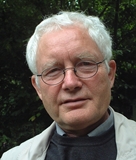Awardee Interviews | Biography: Johan Fremerey
Johan Fremerey

Born 1939 in Stettin, a former German harbour town on the Baltic Sea, Johan K. (Jan) Fremerey received his MSc (1965) and PhD (1969) degrees in physics from Bonn University, Germany. From 1963 to 1974 he worked on magnetic suspension concepts and high speed rotor experiments at the gas ultra centrifuge lab of Wilhelm Groth in Bonn. His primary interest was the experimental search for a tiny rotational decay of freely spinning rotors as predicted by James C. Keith from Detroit on the basis of the Birkhoff and Einstein general theories of gravitation. For that purpose, Fremerey developed a special permanent-magnet rotor suspension with zero-power axial stabilization. This "cavity-type" magnetic suspension also provided the basis of the modern spinning rotor vacuum gauge. In 1972 Fremerey identified, among other effects, a fractional drag that widely matched the theoretical predictions of Keith. These low-budget experimental results obviously have not been taken seriously by the gravitational science community. The growing global interest of the community at that time was the planning and development of high-budget gravitational wave antennas, by now space-born "big-bang observers", for the detection of hypothetical, large scale cosmic events.
As further funding of Fremerey's gravitational search became rather unlikely under these circumstances, he moved to KFA Julich (later on Forschungszentrum Julich) as a staff member of George Comsa's vacuum physics laboratory in 1974. Comsa had recognized the significance of the non-contacting magnetic suspension to instrumentation in the field of vacuum and surface sciences. In particular, he was interested in the development of a commercial spinning rotor vacuum gauge on the basis of Fremerey's suspension system and early vacuum studies at Bonn University.
Fremerey became head of the magnetic bearing section of George Comsa's vacuum physics institute, where he worked in close and fruitful cooperation with Karl Boden, a well known pioneer in the field of permanent magnet bearing technology and former staff member of Wilhelm Groth's ultracentrifuge lab. In 1974, Fremerey and Boden started with the development of magnetically suspended chopper wheels for time-of-flight molecular beam analysis at ultra high vacuum conditions. These devices became a significant basis for the experimental studies of George Comsa and his research team on helium beam scattering at well defined monocrystalline metal surfaces.
The application of permanent magnet bearing concepts devised by Fremerey and Boden has been extended in the following 30 years to light- and neutron beam choppers, spinning anode X-ray tubes, medical gas analysis and pumping devices, turbo molecular vacuum pumps, yarn spinning centrifuges, a GaAs crystal growing plant, a 500-Wh energy storage flywheel, precision light pulse selectors for synchrotron radiation facilities, an implantable blood pump, a turbo charger for automotive application, and others.
After having been introduced as a transfer gauge for the comparison of national vacuum standard facilities by BIPM Paris in 1979 the spinning rotor gauge became commercially available in 1981. In 1985 the commercialization of the spinning rotor gauge was awarded a technology transfer prize from the German federal ministry of research and technology. Turbo molecular pumps have been marketed under license from FZ Julich since 1989. More than 500 blood pumps with Julich-type magnetic bearings have been implanted until 2009 to people suffering from severe heart disease. The production and world-wide distribution of high-speed neutron beam conditioners and light pulse selectors is still continued at the central technology department of FZ Julich.
Fremerey has authored and/or co-authored some 40 scientific papers and about 30 patent applications. In 2004 he received the Albert Nerken Award of the American Vacuum Society "for development of a practical spinning rotor gauge and contributions to the understanding of gaseous drag". After his retirement in June 2004 he has occasionally worked as a consultant in the field of permanent magnet bearing technology, and otherwise enjoys developing new ideas in the field of amateur astronomy.